Guide to Free Arrowhead Appraisal Techniques
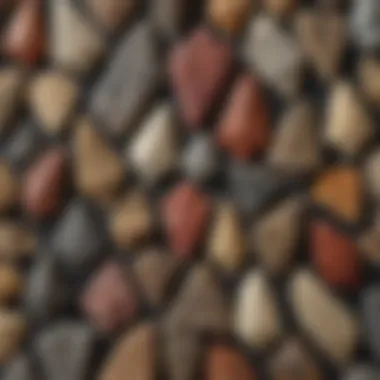
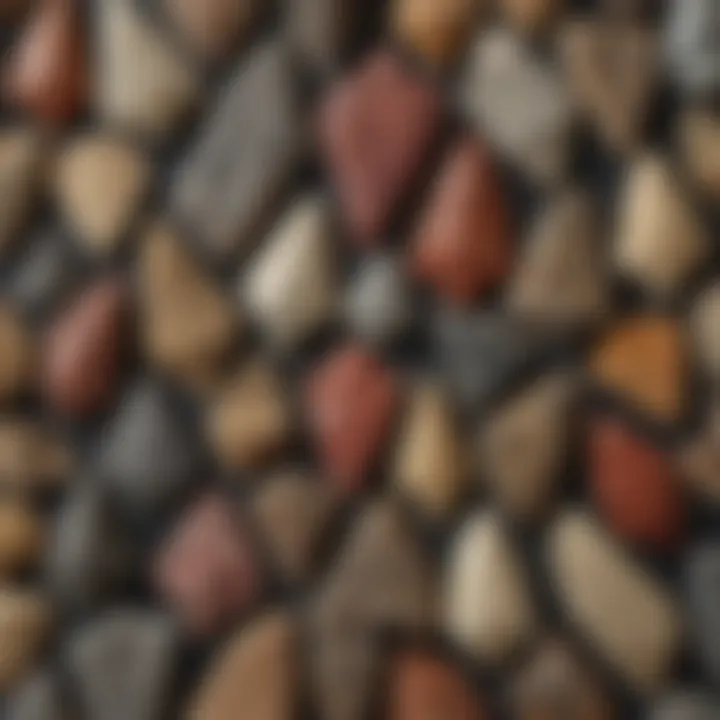
Intro
The world of arrowhead appraisal is like stepping into a treasure chest filled with history, artistry, and significance. Whether you're an eager newcomer or a longtime enthusiast, understanding the nuances behind evaluating these artifacts can greatly enrich your collection. As we dive into this guide, we'll unpack methods to appraise arrowheads, identify their historical context, and explore their material composition, offering you insightful tools to value your finds effectively.
In many ways, arrowheads are not mere tools; they are echoes of the past, encapsulating stories of the people who crafted them. From primitive societies to present-day collectors, each piece carries a unique tale begging to be told. The journey through appraisal is not just about assigning a value; it's about deciphering the language of history inscribed in stone and craftsmanship.
So, let’s embark on this journey, navigating through the depths of arrowhead appraisal, beginning with featured collectibles that might just take your breath away.
Prolusion to Arrowhead Appraisal
The world of arrowhead collecting isn’t just a casual hobby for many. It’s a pursuit that weaves together history, artistry, and a deep appreciation for ancient practices. Understanding how to appraise arrowheads is a crucial aspect of this endeavor, as it helps collectors discern the value of their finds in ways that transcend mere monetary worth. This section serves as a gateway into the significance of appraisal in the realm of arrowhead collecting.
Definition of Arrowhead Appraisal
Arrowhead appraisal refers to the systematic evaluation of these artifacts to determine their value. This encompasses various components, including material quality, historical significance, and condition. Simply put, it’s about understanding what you’ve got in your collection.
While some collectors may casually inspect arrowheads for personal interest, a more thorough appraisal can reveal insights that enhance the overall collecting experience. For instance, an arrowhead crafted from rare stone may not just be more valuable; its uniqueness could tell a story about the ancient culture that made it.
Importance of Appraisal in Collecting
The importance of appraisal in the world of arrowheads can’t be overstated. When you take a step back and look at a collection through the lens of appraisal, you unveil a range of benefits:
- Value Recognition: Knowing what an arrowhead is worth allows collectors to make informed decisions when considering purchases or sales.
- Historical Insight: Appraiising arrowheads can lead collectors to deeper understandings of their origins, providing context that enhances their overall appreciation.
- Preservation Decisions: Recognizing the value and condition of an arrowhead might influence how collectors choose to conserve or display their finds.
- Market Interactions: Well-informed appraisals help in negotiations and exchanges within collector circles, ensuring fair value assessments.
"Understanding the value of your artifacts is not just about collecting; it's about honoring the stories they carry."
Real appreciation goes beyond the surface level, leading to richer engagements with the artifacts. As you delve deeper into arrowhead appraisal, the nuances of what makes each piece unique will shine through, ultimately enhancing your journey as a collector.
Historical Context of Arrowheads
Understanding arrowheads requires a look backward in history. They are not just tools but also vibrant artifacts reflecting human ingenuity. Arrowheads serve as time capsules that tell tales of past cultures, hunting practices, and survival strategies. The historical context of these objects uncovers layers of significance, elevating their value beyond mere collectibles. For collectors, knowing this background enhances the appreciation for their finds and influences their appraisal decisions.
Cultural Significance of Arrowheads
Arrowheads encapsulate rich cultural narratives. For many indigenous cultures, they were more than weapons; they represented mastery over nature and were deeply tied to the community's way of life. Different tribes fashioned arrowheads using local materials, often embedding unique designs that spoke to their identity and values. A classic example is the distinctions between the finely crafted Clovis points used in North America compared to the simpler yet effective designs from other regions.
These artifacts often carry spiritual meanings, representing hunting success and the connection between the tribe, the land, and the hunt. Many have found that studying these aspects can spark a deeper understanding and appreciation for the artifacts on display.
"Arrowheads are not just remnants of the past; they are keys to understanding our ancestors' lives, beliefs, and cultures. Every point unearthed carries a story waiting to be told."
Evolution of Arrowhead Designs
The designs of arrowheads have evolved significantly from the earliest days of their creation. Originally, they were simple implements fashioned from stone, mostly prior to the advent of metallurgy. As time progressed, different materials and techniques gave rise to diverse styles that not only served practical purposes but were also influenced by cultural and technological advancements.
- Early Designs: The very first arrowheads, known as bifaces, were shaped through a process of flaking stone, which brought functionality. These basic points were prevalent across various ancient archeological sites.
- Refinement and Variation: With advancements in tool-making, arrowhead styles began to diversify. New techniques like heat treatment and pressure flaking emerged, creating sharper, more efficient weaponry. Cultures introduced unique shapes, such as the arrowheads of the Woodland period that often exhibited more elaborate forms.
- Modern Implications: Today, collectors often seek pieces that not only represent certain eras or cultures but also embody the advancements in craftsmanship. Some arrowheads can be traced back to specific tribes, carrying their signature style or technique.
Collectors interested in the evolution of designs should pay attention to subtle variations, such as size, shape, and materials used, as these elements reveal a piece's historical journey and cultural significance.
Materials Used in Arrowhead Construction
Understanding the materials used in arrowhead construction is fundamental to the appraisal process. These materials not only determine the aesthetic and functional characteristics of the arrowheads but also influence their historical and market value. Knowing the different substances employed in their crafting helps collectors approach their artifacts with a more discerning eye. Furthermore, having insight into these materials plays a critical role in preservation and restoration efforts. The following sections will cover the types of stone utilized and other materials that find their way into arrowhead making.
Types of Stone Used
When it comes to arrowhead construction, the choice of stone holds a significant weight. Different types of stone have distinct properties that can affect both their utility as tools and their value as collectibles. Here are a few of the most commonly used stones:
- Flint: This is the undisputed champion when it comes to arrowhead making. Flint is renowned for its ability to be sharply edged, making it exceptionally effective when used for hunting. Its fine-grained texture allows for precise flaking, resulting in sharp points. This quality makes flint arrowheads highly sought after in the collector market.
- Chert: Similar to flint yet with a broader color palette, chert can also be shaped into effective tools. Interestingly, its varied hues can range from pale greens to rich browns, making for visually appealing collectibles. The aesthetic diversity can add a layer of interest during the appraisal process.
- Obsidian: Known for its glass-like finish and sharpness, obsidian is less common but incredibly valued when found in arrowhead form. A novel factor with obsidian is its origination from volcanic activity. Not only does it boast beauty, but its historical context can contribute to its overall appraisal.
- Basalt: While not as commonly used as flint or chert, basalt arrowheads are recognized for their heavy-duty construction. An arrowhead made from basalt can signify the wearer’s intent to take on more substantial game.
"The materials have stories to tell—an ancient record written in stone that goes far beyond mere aesthetics."
Each of these stones undergoes distinct flaking and shaping techniques, which hold clues to the era and culture from which the arrowhead originates. Understanding the stone type also aids in determining an arrowhead's historical significance, as certain materials might be more prevalent in specific geographic areas or historical periods.
Other Materials in Arrowhead Making
Aside from stone, various other materials often find their way into the construction of arrowheads, highlighting the varied techniques and traditional methods that differ across cultures. Here’s a look at some lesser-known yet equally fascinating materials:
- Bone: In some contexts, particularly among indigenous tribes, bone was utilized for arrowheads. While less durable than stone, bone points can offer a unique glimpse into survival strategies, especially in areas where hard stones were scarce.
- Wood: Arrowheads were traditionally attached to wooden shafts to enhance functionality. While the wooden parts often decay over time, their historical presence is crucial for understanding the full construction of ancient tools.
- Shell: In coastal regions, shells provided an alternative material for crafting arrowheads. Although not as durable as stone, the carving of shells indicates advanced tool-making skills and resourcefulness of specific cultures.
- Metal: Although primarily a modern development, many collectors find interest in metal arrowheads from the 19th or early 20th centuries. These arrowheads were often produced during a time when traditional skills faced decline, thus sometimes marking a significant cultural transition.
In summary, the materials used in arrowhead construction provide multiple layers of information that inform both appraisal and collectors’ understanding. By recognizing and analyzing these materials, collectors can not only value their finds but also appreciate the cultural narratives encapsulated within each arrowhead.
Methods of Appraising Arrowheads
When it comes to appraising arrowheads, understanding the methods involved is crucial for any collector. The evaluation process is not a straightforward endeavor; it requires a keen eye, a thoughtful approach, and sometimes even specialized tools. The significance of this section lies in equipping collectors, both novice and experienced, with the necessary knowledge to differentiate between authentic artifacts and reproductions.
By mastering the various appraisal methods, collectors can better appreciate the artifacts they own, potentially leading to more informed buying and selling decisions. Knowing how to appraise arrowheads can significantly impact the valuation, ultimately enhancing a collector's ability to navigate the intricate world of artifact collecting. With this foundational understanding, let’s turn our focus towards specific techniques.
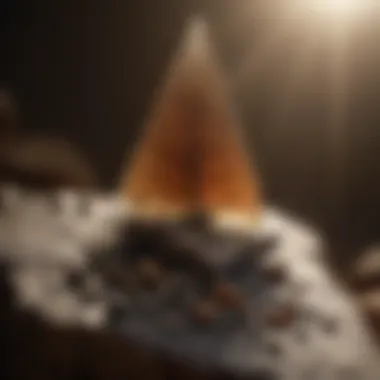
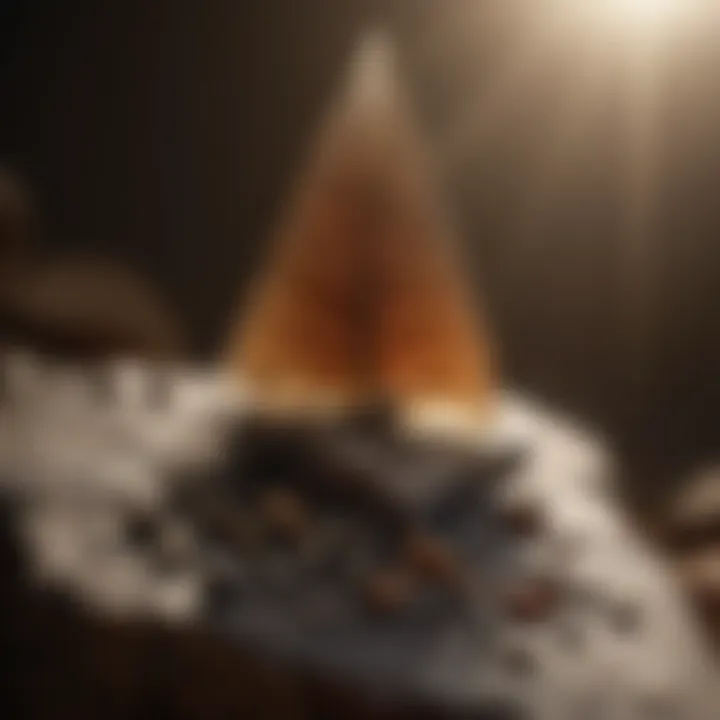
Visual Inspection Techniques
Visual inspection is often the first step in the appraisal process of arrowheads. Collectors can glean a wealth of information simply by observing the item up close. Here are a few essential aspects to consider:
- Surface Texture: The texture can provide clues about the age and the method used for crafting the arrowhead. For instance, traditional knapping techniques produce a unique surface appearance, which differs from modern manufacturing methods.
- Symmetry: Many historic arrowheads, especially those crafted by Native American tribes, exhibit a balance and precision in their shape. If an arrowhead appears unbalanced or poorly formed, it could hint at a lesser quality or be a more modern creation.
- Wear and Tear: Inspecting for scratches, patina, and wear can reveal the artifact’s usage history. A well-loved arrowhead with visible signs of use might hold greater sentimental and historical value.
Doing a thorough initial visual inspection helps in forming an initial hypothesis about the arrowhead’s authenticity and historical context.
Material Analysis Methods
Going beyond visuals, material analysis offers a deeper glimpse into the arrowhead’s origins and significance. Here’s a rundown of some methodologies:
- Petrographic Analysis: This scientific approach involves examining the stone’s mineral content using a polarizing microscope. Understanding the exact type of stone used can help confirm whether it aligns with known sources from specific prehistoric eras.
- Chemical Composition Testing: Analyzing the chemical makeup of the materials can yield insights into the geographical origin of the arrowhead. By examining trace elements, collectors can potentially trace the raw materials to their source, adding layers to the item’s provenance.
- X-ray Fluorescence (XRF): With advanced technology, XRF can identify the elemental composition of arrowheads without causing any damage. This non-invasive method is particularly useful in ensuring that delicate artifacts are preserved during the analysis process.
Incorporating these methods into the appraisal process not only strengthens the collector's credibility but also fosters a richer understanding of arrowheads as historical artifacts. As collectors become more adept in these techniques, they will find their collections taking on a deeper meaning, rooted in an understanding of both the objects themselves and the cultures they represent.
"An arrowhead is not just a stone shaped for a purpose; it is a window into the past, holding stories of those who crafted and used it."
Incorporating both visual inspection and material analysis creates a robust framework for appraising arrowheads. By utilizing these layered methods, collectors can gain a comprehensive understanding of their artifacts, leading to more informed collection practices.
Criteria for Valuing Arrowheads
When it comes to appreciating arrowheads, it's crucial to understand that valuation isn't just about throwing a number at an item. Instead, it’s a careful consideration of various significant elements that tell a story about each artifact. The criteria for valuing arrowheads form the backbone of any sound appraisal process, offering insight into what truly makes these historical pieces special. It encompasses aspects like rarity, condition, and provenance, all of which contribute substantially to an arrowhead's market worth and cultural significance.
Rarity and Condition Factors
Rarity plays an undeniable role in the valuation of arrowheads. An uncommon style or material can shoot the value of an arrowhead through the roof. Imagine stumbling upon a rare Curtiss River material that was primarily used by ancient tribes in specific regions; the worth becomes a reflection of not just its physical characteristics but also the story behind its existence. The more difficult an arrowhead is to find, the more collectors are likely to value it, setting it apart in the crowded market of arrowhead enthusiasts.
On the other hand, the condition of an arrowhead cannot be overlooked. Assessing wear and tear, chipping, or patina can influence its desirability among collectors. An arrowhead in pristine condition often commands a higher price than one that has seen better days. Collectors often have a keen eye for detail, so a thorough visual inspection through magnification glasses, and even tactile examination under good lighting, can help identify factors that may affect condition.
Additionally, one might consider whether repairs were made. Some collectors appreciate well-executed restoration, while others prefer original, unaltered artifacts, which gets them into a bit of a conundrum when it comes to valuation. There's no one-size-fits-all answer, as preference varies widely, but it's an aspect worth pondering if you're looking to either buy or sell.
Provenance and Historical Context
Next to rarity and condition, provenance and historical context hold a celebrated place in the hierarchy of appraising an arrowhead's value. Understanding where—or rather, who—an arrowhead came from doesn’t just appeal to the intellect; it stirs curiosity and respect for cultural heritage. An arrowhead discovered in a documented archaeological site, with evidence of its ancient user, can significantly raise its appraisal value. This deep-seated connection to history can’t be understated.
Collecting the backstory of an artifact isn't just a nice-to-have; it’s central to discerning its worth. For instance, if an arrowhead can be traced back to a prominent collector or a significant archaeological dig, the esteem in which it is held can increase significantly. The combination of tangible elements like rarity and intangible such as its cultural significance creates a rich tapestry that collectors find alluring.
"Understanding the story behind the artifact is just as important as its physical attributes in determining its overall value."
Valuing arrowheads isn't merely about aesthetic or monetary considerations; it’s about the connection to human history that these tiny stone tools represent. Serious collectors often seek out detailed histories because knowing how the arrowhead fits into the bigger picture of its cultural lineage makes it more than just a collecting piece—it's a window into the past.
The Role of Collectors in Arrowhead Appraisal
In the realm of arrowhead appraisal, collectors hold a pivotal role. Their passion and expertise significantly influence the conversation about the value of arrowheads, both in a historical context and as collectibles. This section will delve into the nuances of how collectors impact the appraisal process and enhance the appreciation for these artifacts.
Collector Expertise Levels
Not all collectors are created equal. The level of expertise amongst collectors can vary widely, influencing how they approach appraisal. Here’s a breakdown of the different levels:
- Novice Collectors: Often drawn into the hobby by discovery or mere interest, they usually start with basic and often anecdotal knowledge. Their journey often begins with simple exploration, learning through trial and error, and connecting with others.
- Intermediate Collectors: These individuals have gained a better understanding of arrows. They actively participate in clubs or online communities, such as those on Reddit or specialized Facebook groups, to exchange insights on appraisal techniques and market trends.
- Expert Collectors: Often seasoned collectors, they possess in-depth knowledge about various arrowhead types, historical contexts, and valuation criteria. They are usually well-versed in preservation methods and may even partake in appraising for others. Their expertise is invaluable, providing guidance to both novice and intermediate levels.
Understanding these levels of expertise is important in fostering a sense of community among collectors. Whether someone is new to the field or a seasoned veteran, knowing where they stand can offer perspectives on how appraisal discussions might unfold.
Building a Collecting Network
Cultivating a network is essential for anyone interested in arrowhead collecting. The benefits of creating connections are numerous:
- Knowledge Sharing: A vibrant network allows collectors to share insights on valuation methods, market trends, and preservation techniques. It offers platforms for discussions on where to find resources or what to look for in genuine pieces.
- Collaboration on Appraisals: A network can facilitate collaboration when appraising more complex or unique finds. When collectors pool together their knowledge, they can often reach a more accurate valuation.
- Access to Resources: Joining a network might provide access to localized events, auctions, or exhibitions presenting unique arrowheads. Collectors can benefit greatly from word-of-mouth recommendations for reputable appraisal services or acquiring new arrowheads.
For those looking to build a network, consider participating in local collector meetings or reaching out to online communities. Effective communication is key. Engage in discussions, share your personal experiences, and in turn, lean on others for guidance. This collective knowledge can transform the way individuals approach their own collections and the appraisal process.
Collectors are not just hoarding artifacts; they become part of a larger conversation that preserves history and elevates the significance of arrowheads.
In summary, collectors play an indispensable role in arrowhead appraisal. From various expertise levels to building networks, their impact shapes how these artifacts are valued and understood, ensuring the stories behind them continue to thrive.
Common Mistakes in Arrowhead Appraisal
When venturing into the world of arrowhead appraisal, the landscape is speckled with hurdles that can trip up even the most seasoned collectors. Understanding common mistakes is not just beneficial; it's crucial for anyone looking to accurately assess the value of these artifacts. The appraisal process, while rewarding, can lead to pitfalls that turn passion into frustration if navigated incorrectly. Therefore, a solid grasp of these missteps is key, as it can determine whether one stumbles through the collection maze or treads its pathways with confidence. Collectors must recognize that valuation is not merely a numbers game; it requires an understanding of context, provenance, and expert opinion.
Overvaluation Pitfalls
One of the most significant miscalculation a collector can make is overvaluing an arrowhead. It's easy to get excited about an exceptional find, particularly if it seems unique or carries emotional weight. However, this enthusiasm can cloud judgment.
- Emotional Attachment: Sentimental value often skews the perception of an artifact's market worth. A hand-me-down piece from a grandparent or a stunning specimen discovered under a beautiful oak tree might feel priceless, but the market may not share that view.
- Market Comparisons: Jumping to conclusions based solely on anecdotal reports or inflated online listings is common. Before establishing a price, similar sales should be reviewed meticulously. Websites, auction houses, and forums can offer insight into realistic pricing.
- Ignoring Authenticity: A collector may overlook signs of reproduction when fixated on aesthetics or personal attachment. Utilizing clarity in the evaluation process can safeguard against unwarranted overvaluation; characteristics like finish, material wear, and historicity should always be considered.
"Many collectors mistakenly let sentiment dictate value rather than relying on factual appraisal methods."

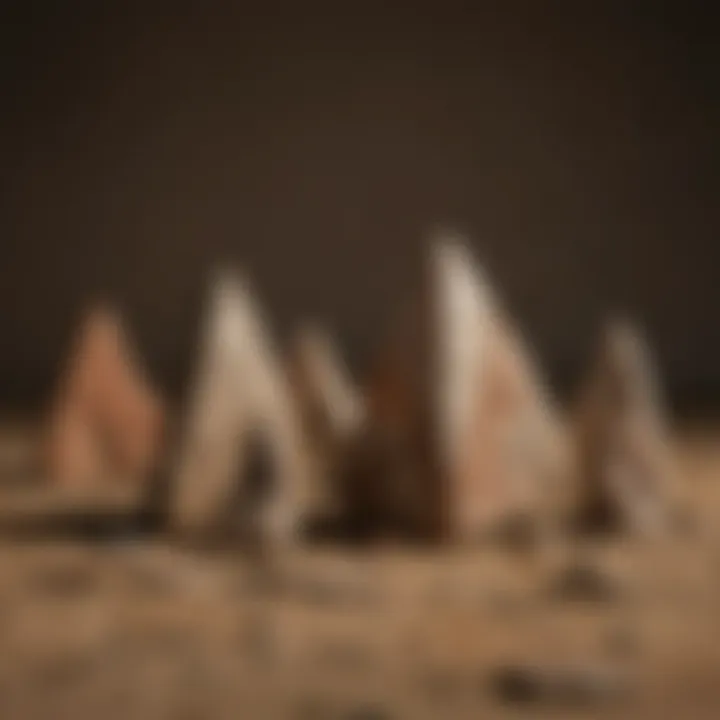
Ignoring Historical Insights
Another prevalent fault is dismissing the historical context of the arrowhead being appraised. Understanding the story behind a piece is just as important as recognizing its physical traits.
- Cultural Background: Each arrowhead originates from a particular time and culture, and overlooking this aspect can lead to misvaluation. Local historical societies and indigenous studies departments can provide invaluable context that elevates understanding of the artifact.
- Archaeological Significance: Assessing its connection to known archaeological sites can greatly influence an arrowhead's worth. If the piece hails from a region where significant archaeological efforts occurred, its value skyrockets beyond mere appearance.
- Documentation of Finds: Engaging in research regarding similar arrowheads that have emerged in the past can provide a wealth of insight. Overlooking archives, databases, and published studies can turn a potentially groundbreaking find into a missed opportunity for deeper valuation.
In summary, making a conscious effort to avoid these common mistakes when appraising arrowheads can lead to more accurate assessments, thereby enhancing not only individual collections but also the integrity of historical artifacts as a whole.
Technological Advances in Appraisal
In the fast-evolving field of arrowhead appraisal, technological innovations are changing the way collectors, appraisers, and historians approach the assessment of these artifacts. These advancements not only improve efficiency but also enhance accuracy in determining the value of arrowheads. As we delve into the specific tools and methods emerging in the market, it becomes evident how pivotal these technologies are to both novice and seasoned collectors.
Digital Tools for Collectors
The digital realm has exploded with tools designed specifically for collectors of arrowheads. These applications and online platforms have streamlined the process of appraisal in several ways. Collectors can now access vast databases containing photographs, specifications, and valuation histories of arrowheads from diverse cultures and time periods. This helps collectors compare their finds with those documented and gauge their worth more accurately.
Among the myriad available tools, mobile photography applications have gained prominence. Indicators such as dimensions, colors, and material characteristics can be easily captured and stored in high resolution. This ability to document artifacts fosters better communication and showcases details to fellow collectors or potential buyers.
Another noteworthy tool is online appraisal platforms that leverage artificial intelligence to analyze images of arrowheads. Such platforms assess market trends by taking into account past sales, offering appraisers insights that static reference books cannot provide. These digital solutions empower collectors to make informed decisions, ensuring they’re not left holding the bag when it’s time to sell.
"Simply put, digital tools transform collecting from an aimless gamble into a calculated pursuit of knowledge and value.”
Emerging Methods in Detection and Analysis
As technology advances, so do the methods for detecting and analyzing arrowheads. One of the most intriguing developments is the use of 3D scanning technologies. By utilizing laser scanners or photogrammetry, collectors can now create accurate 3D models of their arrowheads, allowing for detailed inspection without physical contact. This is particularly crucial for fragile specimens, as it preserves their integrity while facilitating analysis.
Furthermore, x-ray fluorescence (XRF) analysis has emerged as a reliable method for identifying the elemental composition of arrowheads, revealing their construction materials without causing damage. This non-invasive technique helps in determining not just the materials but also the cultural and geographical origins of the artifacts.
Lastly, advancements in machine learning have also made their mark. Algorithms can now classify arrowhead shapes, sizes, and materials, providing valuable insights that would have required painstaking manual labor in the past. Collectors can benefit from these methods as they refine their collections and connect the dots between pieces.
In summary, the incorporation of these technological advances in appraisal serves to not only refine the appraisal process but also deepen collectors’ appreciation for the history and artistry behind their arrowheads. With digital tools making resources more accessible and emerging methods pushing the boundaries of analysis, the world of arrowhead appreciation is becoming ever more precise and informed.
Preservation Techniques for Arrowheads
Preserving arrowheads is not just about keeping them in mint condition; it’s a crucial part of ensuring that these historic artifacts continue to tell their stories for generations to come. Arrowheads hold not only archaeological value but also possess individual historical significance that can be lost if they are not handled or stored properly. By employing effective preservation techniques, collectors can protect their arrowheads from damage while also enhancing their aesthetic appeal and value in the market.
Proper Handling and Storage
Handling arrowheads requires a delicate touch and a fair bit of knowledge. First and foremost, wash your hands before touching any artifact to avoid transferring oils or dirt, which can degrade the item over time. When physically handling arrowheads, it’s wise to wear cotton gloves; this may seem a bit over-the-top, but it prevents fingerprints and other contaminants from marring their surfaces.
Storage practices are just as critical as handling. Storing arrowheads in a climate-controlled environment is essential. Factors like humidity and temperature fluctuations can lead to detrimental effects, causing materials to degrade or even crack. Here are some tips for effective storage:
- Use acid-free containers: Materials that are pH-neutral prevent chemical reactions that might affect the arrowhead.
- Avoid plastic bags: Plastic can trap moisture, which is a no-no. Instead, opt for cloth or paper storage solutions.
- Label storage artifacts clearly with important information such as the date of acquisition, geographical origin, and any other pertinent details. This helps not only in maintaining provenance but also in offering future collectors insights about the piece.
For larger collections, consider utilizing display cabinets made from glass; they allow for visibility while protecting items from dust and direct exposure to harmful elements.
Restoration and Conservation Approaches
Restoration is a sensitive art that requires balancing between preservation and enhancement. Here, the goal is to make an arrowhead look its best without compromising its integrity or historical essence. Restoration methods can vary greatly, so it’s vital to consider the specific needs of each piece. Engaging with skilled conservators who understand the ins and outs of arrowhead restoration is often a recommended course of action.
Nevertheless, collectors can take steps on their own. If an arrowhead is showing signs of wear, first assess what needs to be done. Avoid hasty fixes as they can lead to long-term damage. Professional conservation might include:
- Cleaning: Removing grime or dirt build-up with appropriate materials that do not damage the stone.
- Reconstruction: In cases where pieces are missing, skilled artisans might recreate the missing parts in a way that is historically and aesthetically fitting.
To reach a balanced decision, collecting communities such as those on Reddit can offer suggestions and share experiences regarding specific restoration techniques. Every move should cautiously weigh aesthetic appeal against the possibility of losing context or value.
Quote: "Preservation isn’t a solitary act but a community effort. Each arrowhead brings with it a collective history, and preserving that history is key to understanding our past."
Understanding ethical considerations surrounding restoration is equally important. Observing guideline best practices ensures that you do not inadvertently diminish the cultural significance of the artifact. In this realm, well-researched decisions will stand the test of time, allowing arrowheads to remain valuable and meaningful today.
Ethical Considerations in Arrowhead Appraisal
Understanding the ethical considerations in arrowhead appraisal is essential for collectors, historians, and enthusiasts alike. It's not just about the monetary value; it's also about the responsibility that comes with collecting these artifacts. Collectors need to balance their passion with respect for laws and cultural heritage. This section will take a closer look at two critical aspects of this area: the legal factors that govern collecting activities and the importance of respecting cultural heritage.
Legal Aspects of Collecting
When it comes to collecting arrowheads, the law isn't just a set of rules; it's a framework that shapes how collectors can responsibly acquire and own these items. Each region may have different laws regarding the collection of arrowheads, often rooted in broader regulations about archaeological finds.
- Permits and Permissions: In many areas, collectors are required to obtain permits if they wish to excavate. Engaging in unauthorized digging can lead to legal troubles, including hefty fines.
- Ownership Rights: If found on private land, the ownership of arrowheads can be contentious. Even though a collector may find an arrowhead, they should check property laws to ascertain whether it can be claimed.
- Heritage Legislation: Many countries have laws that protect archaeological sites and their contents. Collectors should be aware of such legislation, which often prohibits the removal of artifacts from protected sites.
Adhering to these legal aspects not only protects the collector but also preserves the integrity of historical sites, ensuring future generations can enjoy these artifacts in their rightful contexts.
Respecting Cultural Heritage
Arrowheads aren't just tools; each piece often tells a story of the people and cultures that crafted them. Therefore, respecting cultural heritage is paramount when it comes to appraisal. Collectors should consider the following:
- Historical Context: Arrowheads provide a glimpse into the lives, practices, and beliefs of ancient cultures. It's crucial to appreciate their historical significance, promoting a deeper understanding among collectors rather than viewing them simply as collectibles.
- Cultural Sensitivity: Many Native American tribes have specific beliefs regarding the handling and collection of their artifacts. Being aware and respectful of these views is not just ethical; it's a vital part of being a considerate collector. If a collector comes across arrowheads that belong to a specific cultural group, they should consider returning the item to its origin or consulting with cultural representatives.
- Preservation and Conservation: The way collectors manage their collections reflects their respect for cultural heritage. Proper storage and handling techniques are essential to prevent damage and degradation of these artifacts.

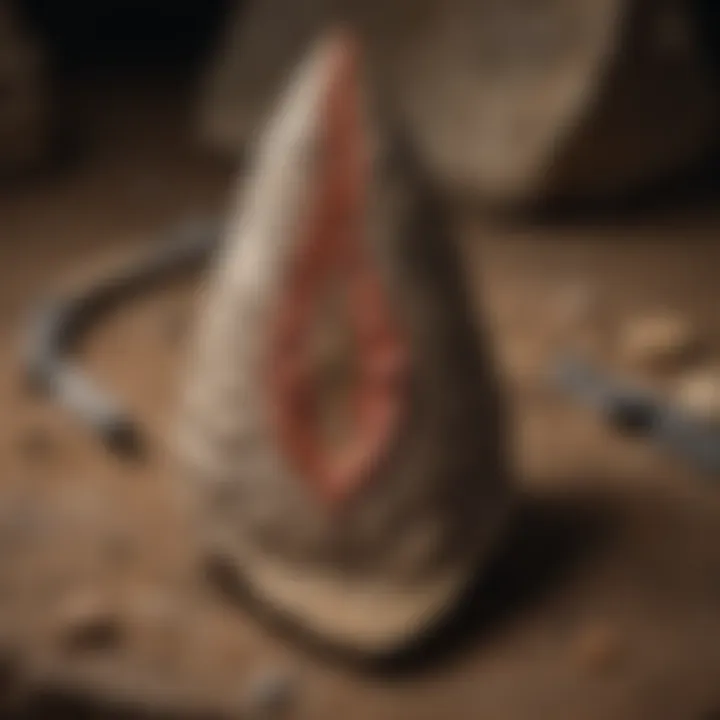
"Collecting should never be a selfish endeavor; it is a responsibility to preserve history for all to share."
By being mindful of these elements, collectors ensure they contribute positively to the field of archaeology while responsibly enjoying their hobby.
Engaging ethically in arrowhead collection can significantly impact the appreciation of these artifacts. Collectors not only elevate their experience but also promote a greater understanding of the importance of cultural heritage and legal obligations.
Market Trends in Arrowhead Collecting
Understanding market trends in arrowhead collecting is akin to reading the winds of change in any collectible niche. This section scrutinizes not only fluctuations in market values but also the driving forces behind these shifts, ensuring that collectors, whether beginners or veterans, remain informed and engaged with contemporary developments.
Evaluating Current Market Values
Market values for arrowheads fluctuate based on several factors, including rarity, condition, and provenance. It's essential for collectors to conduct regular assessments to comprehend the worth of their collections.
Over the years, the prices of arrowheads have seen notable peaks and troughs. Economic conditions significantly affect collector behavior, with market demand often rising during financially favorable times.
Key factors that collectors should consider when evaluating market values include:
- Rarity: Certain arrowheads are rarer than others, which can exponentially increase their worth. Limited production types or those with unique designs tend to fetch higher prices.
- Condition: Well-preserved arrowheads command much higher prices compared to those that are chipped or worn down. Preservation techniques, discussed in other sections, become crucial here.
- Historical Context: The story behind each arrowhead can add considerable value. This link to history often appeals to buyers seeking more than just a collectible.
To support evaluations, utilize resources like the Arrowhead Guide found on Wikipedia.
Understanding Buyer Motivations
Understanding why buyers seek out arrowheads is essential for collectors aiming to capitalize on market trends. Various motivations influence their purchases and can impact market dynamics.
Here are some common reasons buyers pursue arrowheads:
- Nostalgia and Connection: Many buyers are motivated by a personal history tied to arrowheads—be it an ancestral connection, childhood experiences, or regional heritage. This emotional connection often underpins a buyer's willingness to pay a premium.
- Investment Potential: Some collectors view arrowheads not just as hobby items, but as investment opportunities. Individuals targeting high-value pieces often follow market trends closely to make informed purchases.
- Artistic Appreciation: Arrowheads, much like art pieces, can be valued for their aesthetic appeal. The craftsmanship displayed in various designs attracts buyers who appreciate the beauty of these artifacts.
"A collection’s value is so much more than its monetary worth; it’s steeped in memories, stories, and the very essence of human history."
Keeping an eye on these motivations helps collectors align their strategies accordingly, tailoring their collections to meet buyer demand. This insight into buyer behavior is invaluable—it allows seasoned collectors to navigate the market landscape with confidence and empowers newcomers to make wise investments.
Resources for Further Learning
In the ever-evolving world of arrowhead collecting and appraisal, staying informed is vital for enthusiasts. The domain of arrowhead appraisal is not just about possessing a collection; it's about understanding its depths, appreciating the subtle intricacies of materials, designs, and historical contexts. Resources for further learning can guide both novices and experts through the labyrinth of knowledge that surrounds this rich field.
Significance of Learning Resources
Broaden Your Understanding: Diving into recommended readings and reputable websites gives collectors a holistic perspective on arrowheads. Each arrowhead carries a story – from its material composition to the cultures that once used it.
Validation Through Knowledge: Being well-read can aid in better appraisals and avoid common pitfalls. Familiarity with existing literature provides a framework to assess one's collection against established norms.
Community Engagement: Engaging with online forums and websites cultivates a sense of community among collectors. It creates opportunities for discussions, knowledge sharing, and networking, enriching the overall collecting experience.
Recommended Reading and Websites
Staying updated through well-researched publications and online resources cannot be understated. Here’s what to consider:
- Books: Look for titles that offer comprehensive insight into the techniques of appraisal, the history behind arrowheads, and detailed analysis of various types.
- Websites: Reliable platforms, like Wikipedia and Britannica, provide foundational knowledge and historical context that can boost your understanding of arrowhead significance.
- Forums: Sites like Reddit allow collectors to engage with like-minded individuals, offering tips, sharing experiences, and discussing best practices in appraisal.
Books and Publications on Arrowheads
Another cornerstone for collectors is a solid library of books and publications specifically focused on arrowheads. Here are some notable mentions:
- The Collector's Guide to Arrowheads: This book outlines the various types of arrowheads, helping collectors identify and understand what they have.
- American Indian Stone Tools: Delving into the specifics of tools crafted by Native Americans, this resource illustrates how cultural practices intertwine with object valuation.
- Collecting and Preserving Arrowheads: A practical guide for collectors which emphasizes both the aesthetics and the responsibilities tied to ownership.
Investing in knowledge through these resources is not merely for academic curiosity; it is a foundation that enables collectors to handle their pieces with informed respect. Through understanding and research, one can truly appreciate the intricate tapestry that arrowheads weave through history.
End: The Future of Arrowhead Appraisal
As we draw the curtain on this comprehensive exploration of arrowhead appraisal, it becomes clear that this practice is on the cusp of transformation. The continual rise in popularity among collectors, coupled with advances in technology, has the potential to reshape how arrowheads are valued and appreciated. The future of arrowhead appraisal hinges on a few key aspects.
Technological Integration: Digital tools and software that facilitate efficient appraisal processes are increasingly emerging. From online databases that catalog varieties and values, to apps that allow for quick material analysis, collectors are empowered like never before.
Community Engagement: The role of online forums and social media groups could strengthen connections among enthusiasts. As more people share their findings, experiences, and valuations, the collective knowledge will only deepen. This creates a sense of camaraderie and allows for the broadening of perspectives on valuation criteria.
Sustainable Practices: With the growing awareness of respect for cultural heritage, responsible collecting is becoming a mainstay in the hobby. Collectors are more conscious about sourcing finds ethically and engaging in preservation, ensuring that arrows from the past are appreciated in the context of their significance rather than merely as collectibles.
"A collector who understands the story behind the artifact sees it differntly than one who simply views it as a monetary asset."
In sum, the future of arrowhead appraisal is not only about the pieces themselves. It's about how we engage with the stories they carry, the ethics of our collecting practices, and the evolving methodologies of appraisal.
Summarizing Key Takeaways
To wrap it up, a few points stand out:
- Genealogy of Craftsmanship: Understanding the materials and methods used to create arrowheads offers an immersive way into their values.
- Broadened Network: The social aspect of collecting can enrich the experience, helping to foster a responsible community.
- Technological Advances: Tools available today can make appraisal more accessible and accurate.
Encouraging Responsible Collecting Practices
The heart of a passionate collector lies within a framework of ethical and responsible practices. As the community evolves, ao do the standards expected of those who seek to enjoy the treasures of our past. Here are some guidelines to bear in mind:
- Know the Law: Familiarize yourself with the local regulations regarding artifact collection to avoid legal repercussions.
- Respect Cultural Contexts: Always appreciate arrowheads as part of their historical narrative; this contributes to their intrinsic value.
- Engage with Experts: Consult professional appraisers or credible archaeologist services to ensure you are valuing and caring for your artifacts properly.
In the end, the future direction of arrowhead appraisal emerges from a blend of technology, community, and ethical practices, setting the stage for a vibrant and informed collecting culture.



